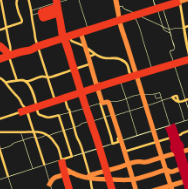 As the City of Toronto inches closer and closer towards the green light for new Metrolinx projects like the LRT lines for Sheppard East and Eglinton Crosstown, GIS will play an ever crucial role in assisting decision makers by framing City-wide issues into a perspective that can be quickly comprehended. Mapping service density aims to identify transit deserts in the overall transit network. These maps emphasize the difference in the levels of service (number of trips) by using darker/stronger colours and thicker lines for higher than average trips, and vice-versa for routes that display below the average number of trips.
As the City of Toronto inches closer and closer towards the green light for new Metrolinx projects like the LRT lines for Sheppard East and Eglinton Crosstown, GIS will play an ever crucial role in assisting decision makers by framing City-wide issues into a perspective that can be quickly comprehended. Mapping service density aims to identify transit deserts in the overall transit network. These maps emphasize the difference in the levels of service (number of trips) by using darker/stronger colours and thicker lines for higher than average trips, and vice-versa for routes that display below the average number of trips.
Averaging Trips per Route
The map below displays my interpretation of service density for the Toronto Transit Comission’s surface network. The data was collected from toronto.ca/open (in GTFS format), compiled in openoffice and linked to bus routes in QGIS. Using the symbolization scheme defined above, the map displays varying levels of trip densities across the City. It’s worth noting that many of the highest density routes are in fact street car lines, including the recent right-of-way St Clair addition to the City of Toronto. One issue with this map is that many routes lie on top of each other, sharing a section of the road network. Averaging the amount of trips on a road segment by segment basis was a little beyond the scope of this project. However, for a more accurate representation, one would want to identify the amount of trips that occur on each line segment, as opposed to the entire route, thereby eliminating the misrepresentation caused by errors in the aggregation.
If this post helped you and you enjoy my site I would happily accept Litecoin donations:
LKPfT772e9HxvXYcA8LVDctTmENoqQxQF3

